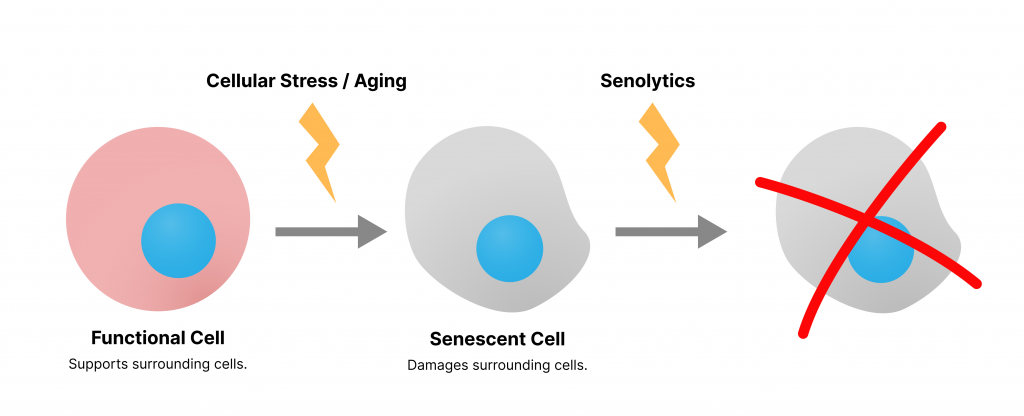When cells accumulate enough damage, especially to DNA, they enter a dormant state called senescence. Senescent cells emit a collection of molecules known as the senescence-associated secretory phenotype (SASP), which includes pro-inflammatory molecules and enzymes that destroy tissue. Senescent cells accumulate with age and, in high numbers, begin to slowly deteriorate the organs they inhabit. Moreover, the deleterious SASP factors includes molecules that stimulate surrounding cells to enter senescence. Thus, senescent cell accumulation promotes tissue degradation and chronic inflammation, which can lead to accelerated aging.
Senescent cells are thought to exist to prevent the spread of tumorigenic cells and aid in wound healing. Unlike normal cells, they can evade programmed cell death (apoptosis). In young, healthy individuals with strong immune systems, senescent cells are eliminated by specialized immune cells. However, our immune systems weaken with age, allowing senescent cells to escape these immune cells and accumulate in numbers. By the time people have reached old age, senescent cells have accumulated throughout the organs of the body, causing inflammation and damage to surrounding cells and tissues. Scientists from leading institutions who study aging believe that senescent cell buildup is one of the primary reasons we age.
Senolytics Prune Senescent Cells
Researchers in the last decade have proposed that removing senescent cells may offer a therapeutic solution to complications arising from their accumulation. They have identified a new class of molecule known as senolytics that destroy these apoptosis-evading cells to reduce inflammation and improve tissue function. Many of these senolytics naturally occur in plants and have been concentrated to achieve doses with therapeutic effects.

Benefits of Senolytics and Senomorphics
Studies have shown that mice exhibit health and lifespan improvement along with SASP reductions from removing senescent cells. Notably, researchers have developed a class of compounds called senomorphics, specifically designed to target SASP factors. Together, targeting both senescent cells and SASP factors with senolytics and senomorphics can potentially mitigate senescent cell progression in a superior fashion than either alone.
Current evidence from animal studies shows that senolytics clear senescent cells and improve vascular aging while reducing cholesterol levels. Senolytics have also been shown to prevent arterial plaque buildup. In animal studies, senolytics have been shown to slow skin aging and help with the progressive degeneration of the joints that negatively impact health.